History of Uncrewed or Unmanned Underwater Vehicles
Uncrewed or Unmanned Underwater Vehicles (UUVs)
are referred to as underwater drones due to their ability to function as a vehicle without any human occupants. These vehicles can also be remotely or autonomously operated, which means they could be controlled by humans to function as desired or operate independently of human commands.
Remotely operated vehicles (ROVs)
are robots controlled by humans, at a distance, for underwater deployment. ROVs are often used in offshore organizations for inspection, repair, and installations due to their benefits in the replacement of human divers (safety, depth, endurance & cost). ROVs function using an acoustic link or tethered cable, receiving commands from an operator onboard.
Autonomous underwater vehicles (AUVs)
on the other hand, are not constrained to cables and constant human supervision; Hence, AUVs are used for more advanced tasks like long-range data collection or hydrothermal inspection.
What did the first Submarine look like?
The First conceptual Submarine design was known to have been made by the British mathematician William Bourne, around 1578. Bourne’s idea led to the world’s first working prototype in the 17th century, which was built by the Dutch inventor and polymath, Cornelius Van Drebbel . Drebble’s prototype was described as a revamped rowboat, coated in greased leather skin and it could remain submerged for several hours. Air was supplied through tubes to the surface and the craft was powered by twelve oarsmen. The concept of a submarine intrigued inventors from many countries, but the lack of a non-human power source was a major problem in its development. In 1620, Drebbel utilized his submarine in a demonstration to King James and his fellow residents of London, diving about 15 feet beneath the Isis River in Southern England.
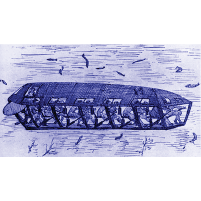
The Journey of UUVs:
We do know that the ancient Greeks harvested valuable sea sponges and dove for treasure. Records tell us that as far back as 333 B.C. Alexander the Great of Greece used a diving bell to descend underwater during the siege of Tyre. The story of Alexander’s underwater adventure was invented and greatly elaborated upon during the course of the Middle Ages, especially in German vernacular literature. Alexander, who was a student of the great philosopher Aristotle, was curious to explore the ocean. He had himself lowered into the water in a glass diving bell, taking with him three creatures: a dog, a cat, and a cock. Alexander entrusted his most loyal mistress with looking after the chain that pulled the bell up to the surface. She was persuaded by her lover to elope, however, and she cast the chain into the sea. With the chain uselessly coiled on the ocean floor, Alexander was left to devise his own escape.

Early 1700 Successful salvage dives by John Lethbridge were made as far down as 65 feet (20 meters) using a wooden barrel equipped with a viewing port.
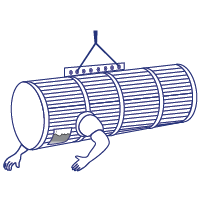
In 1776 American David Bushnell invented a one-man hand-powered submarine that was 71/2 feet long by 6 feet deep (2.5 meters by 2 meters). The vessel was called Turtle because its oak hull looked like two tortoise shells bound together by iron bands. During the American Revolution, it allegedly attempted an attack on the British warship HMS Eagle which was in New York harbor, but the Sub’s torpedo screw could not penetrate the ship’s heavy copper sheathing to plant a delayed-action explosive.

The era of human-powered:
In 1800 Robert Fulton built the first practical hand-powered submarine in France. Total cost for the Nautilus was 10,000 francs. Ballast and buoyancy techniques for the 25-foot vessel were advanced and featured compressed air instead of hand pumps. To submerge, valves flooded the sub’s tanks; to ascend, compressed air forced the water out of the tanks. For depth control it had movable horizontal planes, much like the diving planes on modern submersibles. A year later, Nautilus successfully destroyed a sloop in a submerged attack, but Fulton was unable to interest either France or Britain in his ideas. Eventually he returned to America to build steamboats.
In 1863 The American Civil War saw the first successful submarine attack when the Confederate vessel H.L. Hunley sank the Housatonic. The submarine’s crew were killed in the attack. The Confederate forces in the United States built some 15 ironclad, steam-propelled David vessels. None were meant to submerge but instead took in water ballast so they could run awash at the surface. Nevertheless, they were the first vessels to successfully use the tactic of submergence.
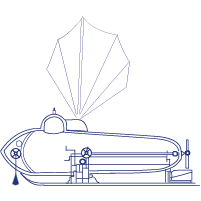
In 1866, the first modernized UUV was fabricated in the image of a self-propelled torpedo. Robert Whitehead was known to be the first inventor of an automobile torpedo, which was propelled by a two-cylinder compressed-air engine.
In 1868, Whitehead’s torpedo was later refined to be an 11-foot, 8-inch model with explosives over 40 pounds (usually inbuilt into the head) with a 200-yard range.
In 1869, Whitehead’s torpedo fueled the mission of an American torpedo, due to the attention it got from David Porter (assistant secretary of the Navy). Between 1870 and 1880, several failed torpedoes had been designed at the United States (U.S) Torpedo station in Newport, Rhode Island; However, a leader of the department of astronomy and navigation at the U.S. Naval Academy, John Howell, decided to design torpedoes in his spare time in 1870. Howell’s design utilized a flywheel inside the torpedo, providing stability and propulsion for the torpedo whiles submersed.
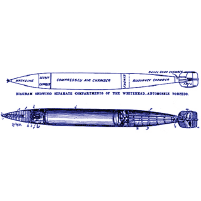
In 1871, Howell patented his design and in 1881 he refined it to be presented as a working model to the world. Unfortunately, after Howell torpedoes entered service in 1895, it was short-lived, due to the prohibition of their launch from steam turbine-powered tubes.
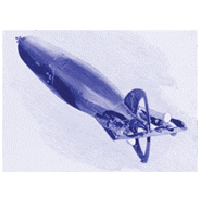
Emergence of Steam, Gasoline & Diesel Power:
In 1878 Irish-American John Holland invented a steam-powered submarine, Holland I. After experimenting with several submarine designs, he sold the U.S. Navy its first submarine which used an electric motor for underwater propulsion and a gasoline engine for propulsion on the surface and for recharging its batteries. Holland’s design set the standard for submarines in both World War I and II, except that diesel engines replaced gas ones.

In 1894 American inventor Simon Lake made several contributions to the development of the modern submarine, notably the free-flooding superstructure. As well, he designed a series of submarines with wheels, such as the Argonaut and Argonaut Jr. so they could crawl on the bottom. Lake felt submarines had potential for commercial purposes, salvage, underwater mining, and various diving operations. He also worked on double hull systems and designed diving suits.

In 1934 Otis Barton designed a bathysphere that could safely take scientists to previously inaccessible depths to gather oceanographic information. He and deep sea exploration pioneer Dr. William Bebee descended to a depth of 3028 feet (1000 meters) off Bermuda.

In 1942 Jacques Cousteau and Emile Gagnan perfected the Aqua Lung or SCUBA (Self-Contained Underwater Breathing Apparatus) breathing regulator, enabling a diver to have complete freedom to work and explore underwater.
During the 1950s, the U.S. created the first AUV to explore the Arctic waters. This research led to the development of the special purpose underwater research vehicle (SPURV). In 1954 The application of nuclear energy to submarine propulsion was a most revolutionary development. The first nuclear-powered sub-war: the USS Nautilus. Although in many respects it resembled an ordinary submarine, its submerged cruising speed of more than 20 knots for an almost unlimited range made it a significant weapon.
In 1957, the University of Washington’s Applied Physics Laboratory developed the SPURV, whiles funded by the Office of Naval Research (ONR). The SPURV was known to dive up to 10,000 feet and last up to four hours, it was also known for its sensors being capable of temperature and conductivity measurements. The SPURVs were used in supporting oceanographic research (acoustic transmission, diffusion studies & submarine wakes). A SPURV II (a refined version of the SPURV) was later created around 1979 after five of the SPURVs were used for service in the U.S Navy.
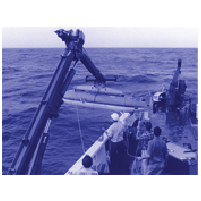
On January 23, 1960, Piccard, accompanied by Lieutenant Don Walsh of the U.S. Navy, dived to a record 10,916 meters (35,814 feet) in the Pacific’s Mariana Trench. A record-setting deep dive in the U.S. Navy bathyscaphe Trieste was set by Jacques Piccard, son of Swiss engineer Auguste Piccard who designed and constructed the bathyscaphe, and U.S. Navy lieutenant Don Walsh. It took the two nearly five hours to descend to 35,800 feet (10,911 m) to the bottom of the deepest place in the ocean, called the Challenger Deep in the Mariana Trench.
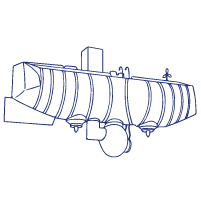
In 1962 Captain Jacques Cousteau launched an experiment in underwater living, designing three Conshelf habitats in the Mediterranean and Red Seas where several men lived and worked for up to a month.
By the 1970s the technology was sophisticated enough to allow a real capability to work in the ocean.

In 1980, emphasis was given to ROVs, leading to the creation of the autonomous and remote-controlled submarine (ARCS). In 1985 Jim McFarlane and International Submarine Engineering Research (ISER) of Canada developed the AUV ARCS for under ice survey, along with numerous ROVs. ARCS development led to most UUVs’ current ability to test platforms with longer battery life, and better navigational and communicational systems.
In 1995, the advancement in battery life allowed for the idea of gliders to be infused into UUV’S. These gliders made it possible for long-term dives and an extended period of submergence.
Going to the early 2000s, the number of users for UUV grew exponentially and the funding increased for its technological development. The user growth for UUVs expanded globally leading to their current use beyond government agencies.
Modern UUVs now take on different forms, completing more complex tasks such as Ship hull inspection, mine hunting, intelligence gathering and exploration. AUVs are now mostly used in the oil and gas industry for surveillance and scientific research, they are also used in naval defense applications like mine detection and payload delivery. Military AUVs, on the other hand, network with unmanned aerial vehicles (drones used for tactical planning and observation) to provide a cross-domain intelligence, surveillance and reconnaissance (ISR) solution for missions. Modern AUVs are powered by rechargeable batteries, fuel cells or solar power and utilize an advanced navigation system due to radio restriction. The Marine Inertial Navigation System (INS) is used to attain the velocity approximation, acceleration and position of the AUV. For propulsion, AUVs utilize electrical thrusters and propellers; however, current underwater gliders (recognized as AUV subsets) manage their depth using variable buoyancy and move forward by converting hydrofoils.
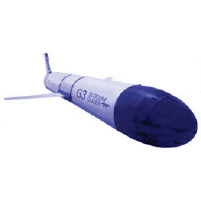
Modern ROVs function in rougher water with a Tether Management System (TSM), which controls the tether’s length to reduce drag effects underwater. Modern ROVs come in different classes (size, weight and function) such as Inspection-Class Vehicles (ICV), Work-Class Vehicles (WCV), and Mini-Class Vehicles (MCV). The MVCs are portable and are used for sensing tasks and pure underwater inspection. The WCVs are the largest and most powerful underwater ROVs due to their ability to manage heavy-duty cables and manipulators. These vehicles use hydraulic pumps, allowing them to dive thousands of feet below water. The ICVs are smaller than the working class and they are usually fitted with cameras/sensors and used in near-shore environments. The Navy is known for its frequent use of UUVs in both the uniformed and civilian fields; Hence they’re constantly looking forward to UUV advancements. The Navy suggests rapid learning effort as a key factor in UUV development as they look into transitioning to the SSN(X) next-generation attack submarine. The SSN(X) is a nuclear-powered attack submarine first discussed by the U.S Navy in 2014, with a budget of over $98 million in research and development. Unlike the Virginia and Seawolf Class attack submarines (predecessors), which were designed for dominance in the littoral, the SSN(X) is designed for greater transit speed in stealth conditions. The SSN(X) is also fabricated for sustenance in combat when facing a great number of threats.

As a means of furthering the development of UUVs, the Department of Navy (DON) offers a federal grant, which is a form of federal financial assistance for ideas and projects. Federal funding is not only built to provide public service but to stimulate the economy and benefit the public. These grants are given to High Schools and Colleges/Universities STEM Students to advance their knowledge of STEM Principles. The Naval Underwater STEM (NUSTEM) team work to build key knowledge on the engineering behind UUVs, human-machine technology interface, and underwater communications. These key knowledge areas are in line with the Navy’s Framework Priorities of the Augmented Warfighter and Sensing & Sense Making. A curriculum lesson is made by the NUSTEM team to emphasize Human-robot Interaction, Undersea Communications, Submarines, UUVs, Bio-robotics, Sea, Air and Space communications and logistics. These proposed lessons will in turn quicken the Navy’s goal for a highly skilled and diverse STEM workforce.
Copyright © 2024 Exploring NUSTEM
Illustrations Recreated from: www.nustem.bridgeport.edu & Build Your Own Underwater Robot and Other Wet Projects. (1997).
